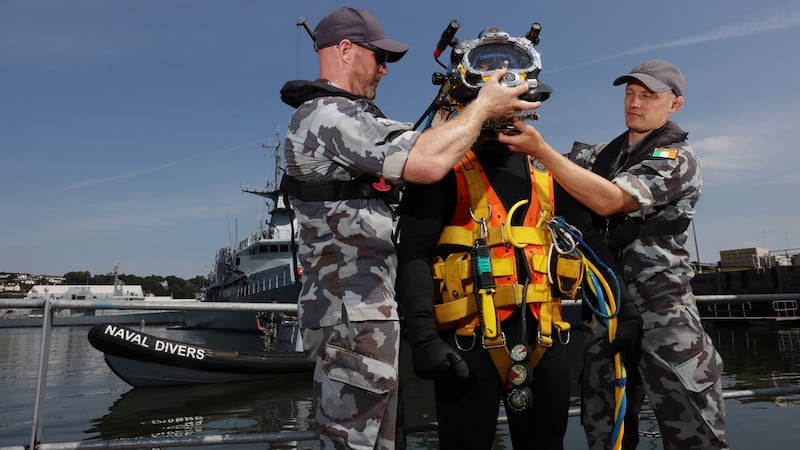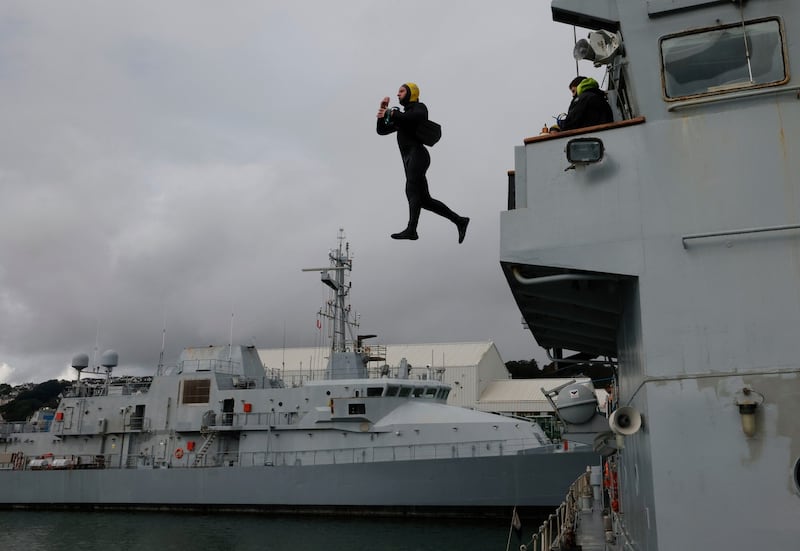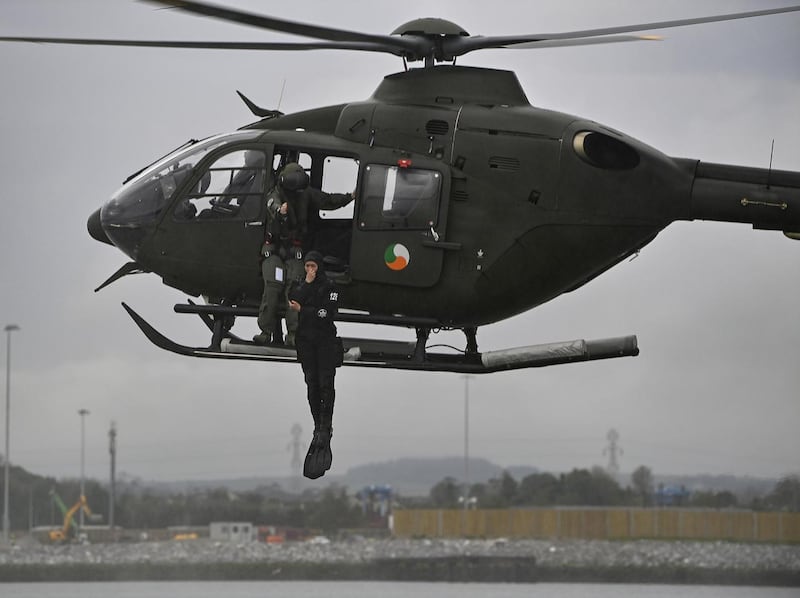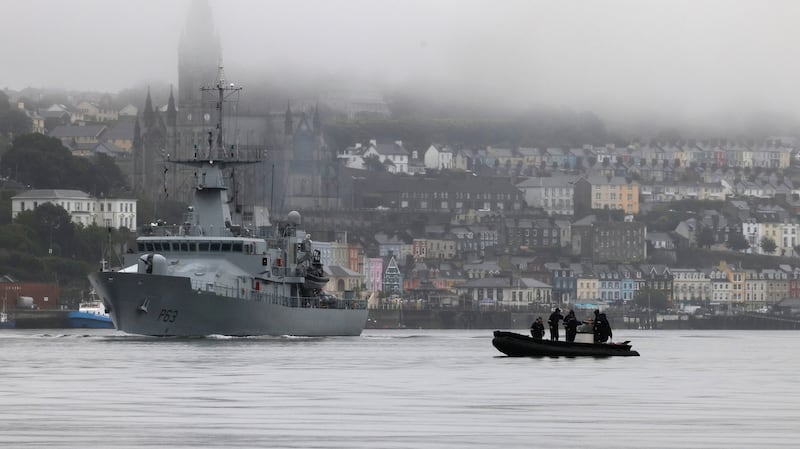It is the darkness that gets to people, explains Lieut Cdr Stephen Stack as he watches the latest class of Naval Service diving recruits going through their physical fitness drills on a day in September.
“People think of diving and they think of coral reefs and colourful fish. Military diving is a different beast. Any visibility you have just goes to nil as soon as you touch the surface and kick up the muck.”
That darkness, combined with the claustrophobia of being up to 60m (almost 200ft) deep, is the reason the course is considered among the toughest in the Defence Forces and why more than 70 per cent of recruits don't make it to the end.
Stack, who is commanding officer of the Naval Service Diving Section (NSDS), remembers starting his diving career with 16 other recruits. On the first day of diving alone, five dropped out.

It is a fine, sunny day at Haulbowline Naval base off the coast of Co Cork and the seven newest students are two weeks in to the 16-week course. Today they are working on the basics, learning how to swim with fins in the open water.
This is the easy part, before the subsurface work starts, Stack explains. “We don’t want to break anyone here. We’re trying to build them up for what’s ahead.”
In the boat, one of the instructors points out a pod of dolphins but the young men swimming alongside take no notice, they are too busy trying not to get left behind.
'Personally, I love the challenge. I love to push myself and the Naval divers are the elite part of the Naval Service'
“If you can get to that buoy in seven minutes you can have an early break,” one of the instructors shouts from the boat.
It is an impossible task and he knows it. A swimmer starts to fall behind. Another asks for permission to go back to help his friend, something Stack is glad to see.
“Teamwork is our most cherished characteristic. Some fellas think it’s being first across the finish line but teamwork is above everything else.”
These lofty words stand in contrast to those of the instructor team. “Are you f**king asleep?” an instructor shouts at another swimmer. “Open your f**king eyes.”
The boat pulls up beside another struggling diver. “I thought you were RTU today diver (returning to unit, ie dropping out)?” the instructor asks.

“No DS,” comes the reply, as loud as he can manage while trying not to inhale seawater. The recruits come from a variety of ranks within the Naval Service and some already have years of experience. But during the course they are all merely “diver” and must refer to their instructors as DS or “directing staff”.
“Will we give them some waves?” the boat operator says with a devious smile. He manoeuvres the vessel in circles around the group, creating an artificial swell and making their task that bit harder.
Back on land, having thoroughly failed to reach the buoy within the time limit, the recruits are given a few minutes to dry off before starting classroom exercises.
One of the recruits, Able Seaman Fergal Harte, seems undeterred. "Personally, I love the challenge. I love to push myself and the Naval divers are the elite part of the Naval Service."
It is ironic that, when it comes to elite units, the highly covert Army Ranger Wing (ARW) is far better known to the public than the Naval Service divers, who operate with much less secrecy.
The physical and mental demands of both units’ training regimes are comparable, as are the attrition rates for applicants.

The disparity is partly explained by the nature the diving unit's work, which skews towards the less glamorous end of military operations. Instead of rappelling out of helicopters or roaming the desert of Mali, Naval divers' most public deployments are operations involving the recovery of human remains from the seafloor.
Other assignments include training the ARW in combat diving, carrying out underwater maintenance on ships and other State assets and the clearance of underwater explosives – mostly second World War-era sea mines.
Narco-torpedoes
One of the unit's more sensitive tasks is searching the outer hulls of ships for drug shipments on behalf of customs. Organised crime gangs are becoming increasingly sophisticated in the transportation of cocaine from South America to Europe and one of their more recent innovations is the "parasitic narco-torpedo", Stack explains.
These are tube-like containers welded to the outside of ships’ hulls, far underneath the water line, which are used to smuggle cocaine. Criminals use scuba divers to attach them and a ship’s crew might be completely unaware of their presence.

Any custom officials searching the inside of a ship’s hull would have no idea it was there; only divers would be able to locate it.
The NSDS has been involved in multiple searches for these narco-torpedoes, Stack says, but have yet to locate any (one torpedo, carrying 75kg of cocaine, was found by a member of the public in Co Clare five years ago, after becoming detached from a passing ship).
Despite its wide range of taskings, the NSDS is facing the same manpower shortage impacting the rest of the Defence Forces, only to a far greater extent.
It is supposed to have 27 personnel. Currently, it has about a third of that. Stack points to the four instructing staff on the quayside, explaining that if a call came in, they would all have to deploy, meaning the suspension of the training course. “That’s not fair on the students or the instructors.”
'The diving section, touch wood, has never lost anyone but unfortunately you don't have to look too far to see how hazardous it can be'
Even at full strength, the unit is still too small, he says. “Realistically, we need three operational dive teams plus support staff. You’re talking the guts of 100 people.”
A submission along these lines has been made to the Commission on the Defence Forces, which is due to issue its report to Minister for Defence Simon Coveney next month.
Pay and conditions are one of the main reasons the NSDS, and the rest of the Naval Service, is so understrength. Another is the lure of the private sector. Trained divers can earn up to €1,500 a day working off oil rigs in the North Sea.
Another factor is the rigorous training course. Military diving is such a hazardous job, that the unit cannot afford to lower its standards to increase manpower. The 70 per cent failure rate has remained relatively constant over the years, although this year Stack is hopeful two, or even three, out of the seven will make it.
“We can’t drop standards to get more lads through. We need to be able to know they are up to a certain standard.”

It is mainly about safety, Stack says. “The diving section, touch wood, has never lost anyone but unfortunately you don’t have to look too far to see how hazardous it can be,” he says, listing of a series of recent recreational diving accidents.
“There’s a lot of risks but if you mitigate your risks by maintaining standards, it becomes a lot safer.”
Milestone
Three months later, in mid-November, Stack’s confidence in the 2021 class has paid off. Three of the students remain on the course and look set to pass.
Last year saw a milestone in the 57 years of the NSDS when Sub Lieut Tahlia Britton became the first woman to pass the course.
"I remember wanting to join the Navy and my guidance councillor telling me, 'No, no, that's not what you want you to do at all'," the Donegal woman recalls. After joining, she started hearing whispers about the diving section and noticing the distinctive badges its members wore on their Naval Service uniform.

“They were kind of revered, at least by me. This was a mystery behind it all. That obviously had kind of an appeal.”
That mystery, combined with her competitiveness, drove her to seek a spot alongside nine other hopefuls. Britton started in January 2020, but the course was suspended five weeks later due to coronavirus. “That was really tough because we had done so much training and we were all really in the zone.”
Maintaining that level of fitness during the pause was a massive challenge. “I know on my strongest day I am at what a male might consider just average strength. So I had to work very hard just to get to that strength before the course.”
When the course eventually did resume, she struggled with the “batterings” and the ever increasing weight of the diving equipment. But she had little trouble with mental pressures of deep sea diving.
The NSDS operates from a ramshackle building at the edge of Haulbowline Island
“A lot of people find it mentally challenging because it’s quiet, you’re on your own and it’s so dark. I had no problem with that. I kind of enjoyed it actually because there’s no one shouting at you.”
The sense of camaraderie with her fellow divers was also vital in making it through.
“No one can do it on their own. I remember sitting in the boat, after just coming out of a dive, shaking with the cold. You’re not allowed to talk in the boat but one of lads beside me just sat a little closer to me and leaned his shoulder against mine to give me some body heat.
“It sounds like such a minor thing but in that moment, I just thought, ‘What would I do without these people’.”
She also recalls the massive pressure put on her to become the first woman to pass. “It was the first thing I was asked about when I finished. And honestly, I think I felt the exact same way as the two other lads who passed. You’re just happy to get over the finish line.”
Ramshackle
The NSDS operates from a ramshackle building at the edge of Haulbowline Island. A decommissioned sea mine sits outside and the only concession to modernity seems to be the solar panels on the roof.
The accommodation belies the fact that, despite its manpower shortages, the unit operates with what Stack says is some of the most advanced equipment available.
This includes a wide variety of diving equipment allowing for missions up to 60m below water using gas mixtures, a mobile decompression chamber and a remotely operated underwater vehicle (ROV). The latter is an unmanned submarine capable of scanning the sea floor which can operate at depths of up to a kilometre.
All of the equipment is stored quay-side in shipping containers, meaning when a task comes in, the required container can be loaded on to a truck for rapid deployment.
One of the most challenging taskings of recent years was an operation off Co Wexford in January 2020. The fishing boat Alize capsized while dredging for scallops near Kilmore Quay.
The body of one crewmember, Joe Sinnott, was recovered soon afterwards but it fell to the Naval divers to find the remains of the boat's captain William "Willie" Whelan.

The operation would take almost three weeks and involve five shipping containers of diving equipment.
First the ROV was deployed to scan the surface and locate the Alize’s wreck. Then divers commandeered the Irish Lights ship ILV Granuaile, which offered the most suitable platform to dive off, and commenced subsurface operations.
They employed a “surface supply” diving system, meaning air was pumped from the surface down to heavy, cumbersome diving suits, a method that allows divers to remain underwater for longer periods.
'I'm not sure if the word is bittersweet but it does give a great deal of satisfaction to be able to bring someone home to their loved ones'
“It was pitch black. We were diving at depths of around 50 metres, which would be right at the edge of our air diving capabilities,” Stack says.
After three diving operations, the captain’s body was finally recovered on January 23rd.
For the NSDS, the Alize operation was a success in that they brought the remains of someone back to a grieving family. How do these operations impact the divers?
“They can be nearly coiled like a spring,” Stack says, especially if the operation takes place in the public eye. However, there are good support systems in place, both from qualified Defence Forces councillors and within the unit. “We will debrief, give everyone a chance to talk about it and have a pint or whatever together,” he says.
“I’m not sure if the word is bittersweet but it does give a great deal of satisfaction to be able to bring someone home to their loved ones,” Stack says. “For Irish people, the whole process of grieving and having a proper funeral is very important.”
He cites the crash of the Coastguard Helicopter Rescue 116 in 2017. Despite the efforts of the Naval divers, and their counterparts in the Garda Water Unit and Royal National Lifeboat Institution, two of the crewmembers bodies were never recovered.
“In those situations, those families will always look out to sea and just wonder.”

















